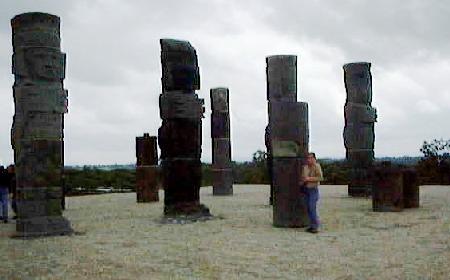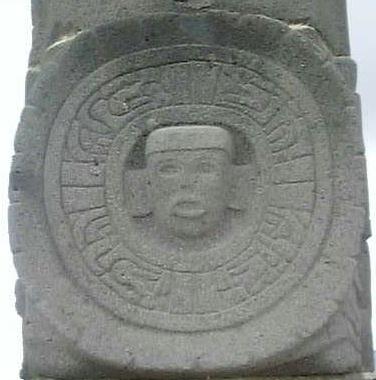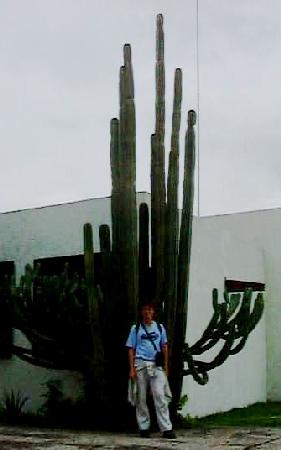
Tula

Veronika and telamones at Tula
Saturday 28th August 1999
We came to Tula from Guanajuato on the Friday, and found a reasonable hotel in the town. We made the short trip to the archaeological zone on the Saturday morning. It was a bleak morning, and the weather looked threatening, but we managed to avoid getting wet, continuing our good fortune with the weather on our travels.
The ancient town of Tula covered nearly 13 square kilometres, but the archaeological zone concentrates on the main ceremonial centre. Much of the town has not yet been excavated, as can be seen from the numerous grassy mounds scattered around the site. Some experts believe that Tula was the capital city of the Toltec people founded in the 10th century by Topiltzin. Topiltzin was supposedly a peaceful priest-king who worshipped Quetzalcoatl, the feathered serpent god. Tula was home to followers of Tezcatlipoca, god of warriors, witchcraft, life and death. Tezcatlipoca appeared in various forms to Topiltzin in order to provoke him. Eventually Topiltzin left for the coast of the Gulf of Mexico, promising one day to return to reclaim his throne.

Detail from a carving on Pyramid B, Tula
Since Topiltzin was light-skinned, long-haired and bearded, the Aztec emperor Moctezuma was concerned when the Spanish conquistador Hernan Cortes arrived on the Gulf Coast in 1519, fearing that he was Topiltzin returned. Most scholars believe that Topiltzin established a new Toltec state at Chichen Itza in Yucatan, leaving the Tula Toltecs to build a brutal military state which dominated much of central Mexico, although there are some who believe that Tula was influenced by Chichen Itza rather than the other way around. Pottery from as far south as Costa Rica has been found at Tula, and the influence of Tula has been detected as far away as Tennessee and Illinois. Tula was eventually abandoned around the turn of the 13th century, having apparently been destroyed by Chichimec raiders from the north.
The site itself is dominated by the temple of Quetzalcoatl or Tlahuizcalpantecuhtli, referred to as Pyramid B (it's easier to spell). On top of the pyramid stand four telamones, statues of male figures used instead of pillars to support a roof. Originally, there was a temple on top of the pyramid which would have housed the telamones, but there is little trace of that now. The pillar-figures are shown carrying spear-throwers in their right hands, leading Eric von Daniken to conclude that they actually represent spacemen, but more conventional theories suggest that they represent Quetzalcoatl as the morning star ("Tlahuizcalpantecuhtli"). Originally the pyramid would have been surrounded by carvings representing the symbols of the warrior orders (jaguars, coyotes, eagles), but the only traces of these are to be found on one side.

Detail of a disk on the back of one of the telamones at Tula

Head of a telamon at Tula
Pyramid B looks on to the open plaza, which would have been the site of religious and military displays. On one side of the plaza is a ball-court, the largest in central Mexico at over 100 metres long. The ball game was of great importance in pre-Hispanic Mexico, although no-one seems to know how it was played. There is some evidence to suggest that either the captain or a whole team were sacrificed, but scholars can't decide whether it was the winning team (great honour to be sacrificed) or the losing team. Either way, death at the end would have been a great motivator. Ball courts are to be found at many sites around central America, and doubtless I will mention them again as we visit more sites.

Fergus and giant cactus at Tula
Mexico index | Travel index | Family history | Romany | Main index